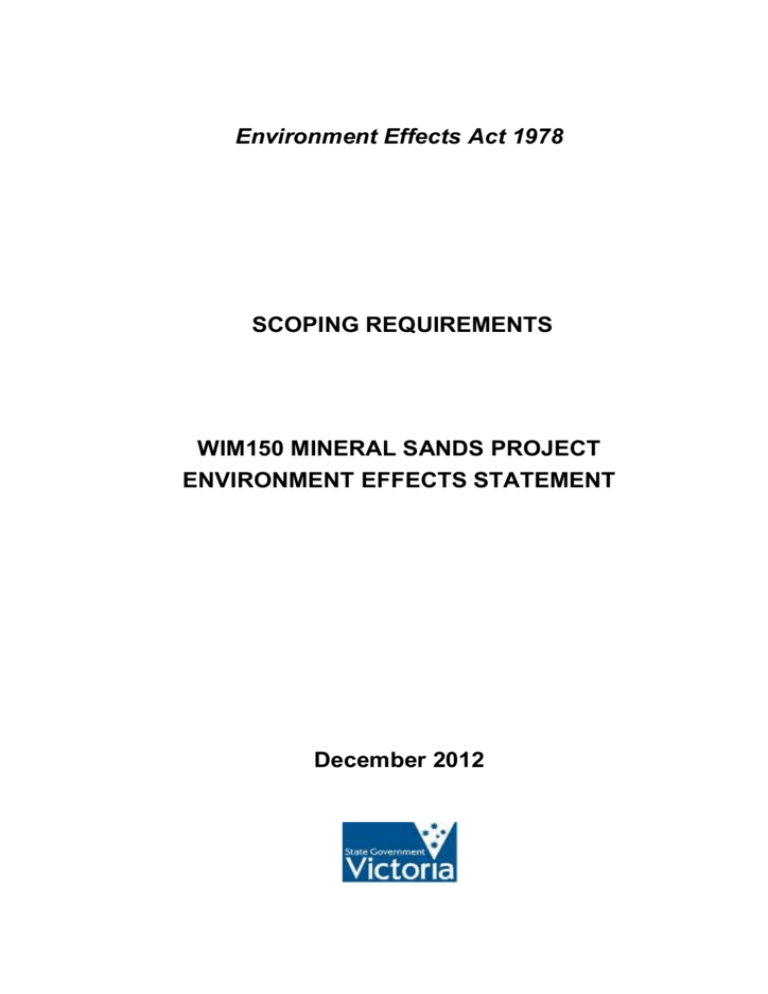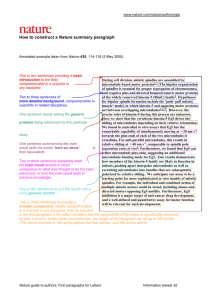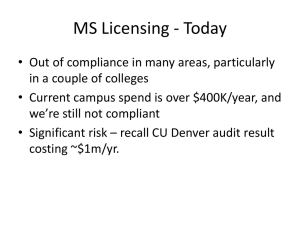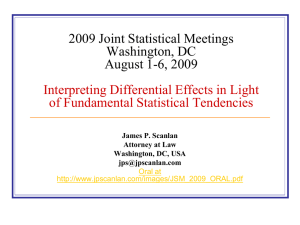Final Scoping Requirements - Department of Transport, Planning
advertisement

Environment Effects Act 1978 SCOPING REQUIREMENTS WIM150 MINERAL SANDS PROJECT ENVIRONMENT EFFECTS STATEMENT December 2012 WIM150 Mineral Sands Project EES Scoping Requirements ________________________________________________________________ List of Abbreviations CHMP Cultural Heritage Management Plan DPCD Department of Planning and Community Development DSE Department of Sustainability and Environment EE Act Environment Effects Act 1978 EES Environment Effects Statement EPBC Act Environment Protection and Biodiversity Conservation Act 1999 FFG Act Flora and Fauna Guarantee Act 1988 MRSD Act Mineral Resources (Sustainable Development) Act 1990 NIRV Noise from Industry in Regional Victoria, EPA Publication No. 1413 (2011) NVMF Victoria’s Native Vegetation Management - A Framework for Action (2002) SEPP State Environment Protection Policy TRG Technical Reference Group ii WIM150 Mineral Sands Project EES Scoping Requirements ________________________________________________________________ TABLE OF CONTENTS 1 INTRODUCTION ................................................................................................................ 1 1.1 1.2 1.3 1.4 2 REQUIRED APPROVALS AND ASSESSMENT PROCESS ......................................... 4 2.1 2.2 2.3 3 OVERVIEW OF THE EES PROCESS ....................................................................................... 4 REQUIRED APPROVALS ...................................................................................................... 6 COORDINATION OF EES AND APPROVAL PROCESSES ......................................................... 6 GENERAL REQUIREMENTS FOR THE EES ............................................................... 8 3.1 3.2 3.3 3.4 3.5 3.6 4 PURPOSE OF THIS DOCUMENT ............................................................................................. 1 THE PROPOSED PROJECT ..................................................................................................... 1 MINISTER’S REQUIREMENTS FOR THIS EES ........................................................................ 2 ACCREDITED PROCESS........................................................................................................ 3 GENERAL CONTENT OF THE EES........................................................................................ 8 PROJECT DESCRIPTION ....................................................................................................... 9 RELEVANT ALTERNATIVES .............................................................................................. 10 EXISTING ENVIRONMENT ................................................................................................. 10 APPLICABLE LEGISLATION, POLICIES AND STRATEGIES ................................................... 11 DRAFT EVALUATION OBJECTIVES .................................................................................... 12 ASSESSMENT OF SPECIFIC ENVIRONMENTAL EFFECTS ................................. 14 4.1 4.2 4.3 4.4 4.5 4.6 4.7 4.8 4.9 4.10 4.11 GENERAL APPROACH ....................................................................................................... 14 RESOURCE DEVELOPMENT ............................................................................................... 14 WATER AND SOILS ........................................................................................................... 15 REHABILITATION .............................................................................................................. 16 SOCIAL CONSIDERATIONS ................................................................................................. 17 CULTURAL HERITAGE ...................................................................................................... 18 LANDSCAPE VALUES ........................................................................................................ 19 ECOSYSTEMS AND BIODIVERSITY .................................................................................... 19 INFRASTRUCTURE ............................................................................................................ 21 ENVIRONMENTAL MANAGEMENT FRAMEWORK ............................................................... 21 OVERALL OUTCOME......................................................................................................... 22 iii WIM150 Mineral Sands Project EES Scoping Requirements ________________________________________________________________ iv 1 INTRODUCTION 1.1 Purpose of this document On 23 December 2011, the Victorian Minister for Planning determined that Australian Zircon NL should prepare an Environment Effects Statement (EES) under the Environment Effects Act 1978 (EE Act) for the WIM150 Mineral Sands Project. This document constitutes the EES Scoping Requirements for the WIM150 Mineral Sands Project. This document has been finalised following the receipt and consideration of comments received during the public exhibition of the draft Scoping Requirements. The document sets out the range of matters to be investigated and documented in the EES. 1.2 The proposed project Australian Zircon NL proposes to develop the WIM150 mineral sands deposit across 12,850 hectares in the Wimmera region of western Victoria, approximately 20 kilometres southeast of Horsham. The WIM150 mineral sands deposit is within Exploration Licence No. 4521. In outline, the proposal includes the development of a mineral sands mine, wet concentrator plant, mineral separation plant and tailings thickening and disposal plant, together with other site infrastructure (i.e. site office, car park, warehouse and workshop facilities, loading facilities and fuel storage). The mine may use an open pit dry mining method or a combination of open pit and dredge mining methods. It is expected to initially process 12 million tonnes of ore per annum, which may progressively increase to 25 million tonnes per annum during the projected 25-year mine life. Ten megawatts of power is likely to be required for the mineral sands project (i.e. for ore processing), which would be supplied either from the existing 220 kilovolt transmission line traversing the site or from on-site electricity generation using natural gas. In addition, the project may require a supply of natural gas for processing of the heavy mineral concentrate. Construction of a gas pipeline connecting the project site to the existing gas pipeline to Horsham would be required. It is expected that fuel tankers will deliver fuel to the site fuel storage twice per week for operation of mining mobile equipment, entering the mine access road from the Western Highway. Heavy mineral concentrates could be transported via road and/or rail to a port for export overseas. Road transport from the project site is expected to be comprised primarily of B-double trucks taking mineral sands product out the mine gate onto the Western Highway for delivery to export facilities. The project area is mostly broad flat plains to the north of foothills of the Grampians Ranges, with some lunettes, swamps and low ridges. It has been significantly modified by agricultural activities, and contains areas of remnant vegetation associated with lakes, wetlands, drainage lines and roadsides. The project area largely consists of freehold land used for agriculture. WIM150 Mineral Sands Project EES Scoping Requirements ________________________________________________________________ 1.3 Minister’s requirements for this EES The core requirements applying to the EES for this project, in accordance with the Minister’s decision under sections 8B(4)(a)(i) and 8B(5) of the EE Act, are as follows: “The EES is to document the investigation of potential environmental effects of the proposed project, including the highway realignment1 , and energy supply options, and any relevant alternatives (such as for the mine plan, method for mining and processing, and transport), including associated environmental mitigation and management measures, in particular effects on: a. Surface water and groundwater hydrology, quality, aquatic ecology and availability; b. Biodiversity and ecological values within and near the site, and associated with adjacent road reserves and riparian areas, including: native vegetation; listed ecological communities and species of flora and fauna under the Flora and Fauna Guarantee Act 1988 (FFG Act); and other habitats and vulnerable and protected species; c. Land stability, erosion and soil productivity associated with the construction and operation of the project, including rehabilitation works; d. Aboriginal and non-Aboriginal cultural heritage values in the vicinity of the project site; e. Local and regional air quality and beneficial uses potentially affected by the construction and operation of the project; f. Land uses and landscape values of the site and surrounding areas, including the implications for the Grampians National Park; g. Amenity of nearby sensitive receptors (in particular dwellings), during the construction and operation of the project; h. Socio-economic values, at local and regional scales, potentially generated by the project works, including indirect effects on the capacity of local community infrastructure in relation to the project construction workforce; and i. Solid and liquid waste that might be generated by the project during construction and operation”. These Scoping Requirements further specify the requirements for the EES, in the context of the Ministerial guidelines for assessment of environmental effects under the Environment Effects Act 1978 (Ministerial Guidelines). 1 Note in relation to the first paragraph of the Minister’s requirements above, the proponent has advised DPCD that realignment of the Western Highway is no longer being considered as part of this project. 2 WIM150 Mineral Sands Project EES Scoping Requirements ________________________________________________________________ 1.4 Accredited process The project was referred to the Australian Government under the Environment Protection and Biodiversity Conservation Act 1999 (EPBC Act). The delegate for the responsible Commonwealth Minister determined the project to be a controlled action on 6 July 2012. The relevant controlling provisions for the project under the EPBC Act are: National Heritage places (sections 15B & 15C); Listed threatened species and communities (sections 18 and 18A); and Listed migratory species (sections 20 and 20A). The EES process is to be applied as an accredited assessment process under the EPBC Act in accordance with the bilateral agreement between the Commonwealth and Victoria. The Australian Government Minister for Environment will ultimately make a decision whether to approve the project under the EPBC Act. 3 WIM150 Mineral Sands Project EES Scoping Requirements ________________________________________________________________ 2 REQUIRED APPROVALS AND ASSESSMENT PROCESS 2.1 Overview of the EES Process Main process steps Australian Zircon NL, the proponent, is responsible for the preparation of the EES, while DPCD will manage the EES process. The EES process for the WIM150 Mineral Sands Project will include the following steps (see Figure 1): Preparation of Draft Scoping Requirements by DPCD; Release of Draft Scoping Requirements by DPCD for public comment; Issuing of final Scoping Requirements by the Minister for Planning; Preparation of the EES by the proponent; Review of the draft EES by DPCD (in consultation with relevant agencies) in terms of its adequacy for public exhibition; Authorisation by the Minister for Planning for DPCD (on behalf of the Minister) to invite public comments on the EES; Exhibition of the EES by DPCD for public comment for a period of 30 business days for public comment; Appointment of an Inquiry by the Minister for Planning to review the EES and any public submissions, conduct public hearings and provide a report to the Minister; Following receipt of the Inquiry report, preparation of an ‘Assessment’ of the project’s environmental effects by the Minister for Planning; and Provision of the Minister’s Assessment to relevant decision-makers. Project management and consultation by proponent The proponent is to prepare and submit to DPCD: A draft proposed schedule for the technical studies, preparation and exhibition of the EES, following confirmation of the Scoping Requirements to enable alignment of the proponent’s and DPCD’s timeframes, including for the review of draft EES documentation; An EES Consultation Plan (which will be published on the DPCD website) for informing the public and consulting with stakeholders during the preparation of the EES, having regard to advice from DPCD and the TRG. The proponent should progressively revise the Consultation Plan, as necessary, as the EES progresses. Stakeholders include potentially affected parties, the community and interested organisations and individuals, as well as the government agencies formally involved in the process. This plan should: 4 WIM150 Mineral Sands Project EES Scoping Requirements ________________________________________________________________ - Provide the details of a designated contact person during formal public consultation steps of the EES process (i.e. public comment periods on the draft Scoping Requirements and final EES documentation); - Identify relevant stakeholders, their interests and consultation needs, as well as their potential ability to provide relevant input to the EES; - Describe the consultation methods to be used and provide a schedule of activities; and - Outline how inputs from stakeholders will be recorded, considered and/or addressed in the preparation of the EES. Technical Reference Group DPCD will convene an inter-agency Technical Reference Group (TRG) to advise both DPCD and the proponent on the following matters: Scoping Requirements for the EES; Design of technical studies to address the Scoping Requirements; Opportunities to mitigate potential environmental effects; Adequacy of the EES studies and the proposed mitigation measures and related environmental management measures; Design and implementation of the proponent’s EES Consultation Plan; Relevant policies, strategies and statutory provisions; and Coordination of statutory assessment and approvals processes. The TRG comprises invited representatives of relevant state government agencies as well as Horsham Rural City Council. Further information on the EES process can be found at DPCD’s website: www.dpcd.vic.gov.au/planning/ees 5 WIM150 Mineral Sands Project EES Scoping Requirements ________________________________________________________________ 2.2 Required Approvals Subject to the assessment outcomes, the project will require approvals under Victorian legislation prior to commencement of any works: A Mining Licence, approved Work Plan and Work Authority under the Mineral Resources (Sustainable Development) Act 1990 (MRSD Act); and An approved Cultural Heritage Management Plan (CHMP) under the Aboriginal Heritage Act 2006. Approvals or consents may also be required under other legislation, including: Granting of a licence to extract and use groundwater or surface water under the Water Act 1989, for dewatering the mine, ore processing and for water supply purposes; Approval from the Minister for Environment and Climate Change to remove native vegetation of very high conservation significance in accordance with Victoria’s Native Vegetation Management - A Framework for Action, 2002 (NVMF); Approval under the Commonwealth EPBC Act for any potential effects on matters of national environmental significance; Extinguishment of Native Title claims over the project area, under the Traditional Owner Settlement Act 2010; Authorisation from the Department of Sustainability and Environment (DSE) to take and/or disturb flora or wildlife under the FFG Act and Wildlife Act 1975 respectively; and A Management Licence under the Radiation Act 2005 from the Department of Health in relation to radioactive material. This project is exempt from a planning permit under Clause 52.17-6 of the Horsham Planning Scheme as a planning permit is not required to use or develop land for mining if a project is assessed under the EE Act. 2.3 Coordination of EES and Approval Processes The Minister’s Assessment under the EE Act will inform decisions under other legislation whether to approve the project, but it does not constitute a statutory approval in its own right. Within the framework of the EES process, DPCD will coordinate the preparation and exhibition of the EES with relevant information and public notice requirements under applicable approvals legislation. Figure 1 shows the coordinated statutory assessment and approval pathways for this project. 6 WIM150 Mineral Sands Project EES Scoping Requirements ________________________________________________________________ Victorian Process Environment Effects Act 1978 Coordinated approval process: - Mineral Resources (Sustainable Development) Act 1990 - Aboriginal Heritage Act 2006 - Water Act 1989 - Planning and Environment Act 1987 - Wildlife Act 1975 - Radiation Act 2005 Commonwealth Process Environment Protection and Biodiversity Conservation Act 1999 EES Referral submitted to Minister for Planning on need for an EES EES required under the Environment Effects Act 1978 Public comments Draft EES Scoping Requirements prepared by DPCD & exhibited Commonwealth determine proposal is a Controlled Action under the EPBC Act Accreditation of Victorian EES process under the Bilateral Agreement for Environmental Impact Assessment Scoping Requirements issued EES studies undertaken by proponent & reviewed by TRG Draft EES prepared by proponent & reviewed by DPCD Public comments EES exhibited together with relevant approval documentation for comment EES Inquiry Panel - Public Hearings Inquiry Panel Report prepared Minster for Planning's Assessment Commonwealth consideration under EPBC Act Victorian decision-makers’ consideration of Minister’s Assessment Decisions under applicable laws Figure 1 Commonwealth decision under EPBC Act Statutory assessment and approval pathway for the project 7 WIM150 Mineral Sands Project EES Scoping Requirements ________________________________________________________________ 3 GENERAL REQUIREMENTS FOR THE EES 3.1 General Content of the EES The EES should enable interested stakeholders and decision-makers to understand and make an informed response to the proponent’s assessment of the likely environmental effects of the project and the manner in which these effects are proposed to be managed. The EES should consist of a main synthesis report supported by technical appendices containing relevant data and analysis. The main report should provide a clear, succinct and well-integrated analysis of the potential effects of the likely environmental effects of the project and relevant alternatives, including proposed mitigation and management measures. Consistent with the Ministerial Guidelines, the EES should incorporate the following elements: An executive summary of the likely environmental effects of the project; A description of the project’s objectives and rationale, as well as its relationship to relevant policies and plans; A description of the entire project, including associated offsite infrastructure requirements; A description of relevant alternatives capable of substantially meeting the project’s objectives, including alternatives that may have less potential effect on the environment or even offer environmental benefits (as well as the basis for the choice where a preferred alternative is nominated); A summary of the approvals required for the project to proceed and the intended approach for obtaining them; A description of the existing environment, particularly where this is relevant to the assessment of likely effects; Appropriately detailed investigations of likely effects of the project (including relevant alternatives) on environmental assets and values, relative to the ‘no project’ scenario. Where relevant, assessments should encompass direct and indirect, combined, short and long term, beneficial and adverse effects and consequences, together with an estimation of the likelihood and degree of uncertainty associated with each prediction; A description of the risk assessment process and evaluation framework used to consider the likely environmental effects and their significance; Measures for avoiding, minimising, monitoring and managing effects, identified through the assessment, including a statement of commitment to implement these measures, Assessments of residual effects of the project, assuming implementation of the proposed mitigation measures and other environmental management measures, including any measures proposed to compensate for the residual effects; Responses to issues consultation; and raised during community and stakeholder 8 WIM150 Mineral Sands Project EES Scoping Requirements ________________________________________________________________ Evaluation of the implications of the project and relevant alternatives with respect to applicable legislation and policy, including the principles and objectives of ecologically sustainable development and environmental protection. The proponent is to prepare a concise summary document (hard copy A4) for free distribution to interested parties. It is to summarise the EES findings, and describe the EES exhibition process and availability of the EES reports. Close consultation with DPCD during the investigations and preparation of the EES is needed to ensure the final documents are of a standard suitable for the Minister for Planning to authorise the EES for public exhibition. The proponent is to apply appropriate peer review and quality management procedures to enable the completion of EES studies to a satisfactory standard. The required scope and content of the EES is covered in the following sections. 3.2 Project Description The EES is to sufficiently describe the project to both allow an understanding of all components, processes and development stages (if relevant), and to enable assessment of their likely potential environmental effects. Specifically, the EES is to describe the following aspects of the project, to the extent practicable. Mine development including construction of facilities The project’s objectives and rationale, including the implications of the project not proceeding. The proposed site layout and access arrangements during construction. The main components of works and their function including design capacity, operational life and scheduling of the proposed mining works. Location and function of key ancillary facilities, including a wet concentrator plant, mineral separation plant and tailings thickening and disposal, as well as site office, car park, warehouse and workshop facilities, loading facilities and fuel storage. Necessary works directly associated with the project, such as infrastructure and services upgrading and relocation, including potential road and other linear infrastructure development (i.e. transmission lines, pipelines). Proposed construction techniques and extent of areas to be disturbed during construction, including particular requirements for traffic and floodwater management (including sediment control), dust and noise management, as well as for sensitive environmental locations. Mining operations The proposed site layout and access arrangements during mine operation. Lighting, safety and security requirements. 9 WIM150 Mineral Sands Project EES Scoping Requirements ________________________________________________________________ Operational activities including dust and noise management, hours of operation, workforce numbers and recruitment policies during construction and operation. Approach to be taken regarding mine site rehabilitation. Proponent’s health, safety and environmental policies and relevant experience in developing and operating projects. 3.3 Relevant Alternatives The EES should investigate and document the likely environmental effects of relevant alternatives capable of meeting the objectives of the WIM150 Mineral Sands Project. In the first instance, it should provide an outline of: The basis for selecting the area proposed to be mined within the broader boundaries of the exploration licence in the context of the concept mine plan, including alternatives for the layout and staging of the mine; The site selection process for the processing and ancillary facilities; The technical feasibility and environmental implications of alternative construction, mining, ore processing and site rehabilitation methods; and Relevant alternatives for electricity, water, gas and fuel supply, transport of products and workers and solid and liquid waste disposal. Where appropriate, the assessment of environmental effects of relevant alternatives is to address the matters set out in the subsequent sections of this document. The evaluation of alternatives should take into account applicable legislation and policy, as well as the draft evaluation objectives (see section 3.6). The depth of investigation of alternatives should be proportionate to their potential to both meet the objectives of the project and provide a credible opportunity to minimise potential adverse effects, in the context of relevant evaluation objectives (see section 3.6). An exhaustive assessment of all alternatives is not required. However, the EES should aim to present adequate information to enable understanding of the process used to eliminate alternatives and to establish the preferred project definition. 3.4 Existing Environment The EES should incorporate a general description of the features of the environment within and in the vicinity of the project. The description should be sufficient to provide a reliable basis for the prediction of likely environmental effects in relation to key matters. The description should: Provide an overview of the regional environmental setting; Provide a detailed description of local environments that are directly and may be indirectly affected by the project, including: - details of any values and uses of the environment, and any notable features; 10 WIM150 Mineral Sands Project EES Scoping Requirements ________________________________________________________________ - assessment of each aspect of the environment’s sensitivity to change or disturbance; and - suitable maps, plans, photographs, diagrams and other descriptive detail on the above. Combine existing information with sufficient field data to provide a reliable basis for prediction of effects; and Clearly identify the sources and reliability of the information used. 3.5 Applicable Legislation, Policies and Strategies The EES is to identify relevant legislation, policies and strategies, and assess their specific requirements or implications for the project – particularly for the required approvals. The EES should outline the relevant State and Commonwealth legislation, including: Environment Effects Act 1978; MRSD Act; Environment Protection Act 1970 (including the principles of environment protection), and relevant State Environment Protection Policies (SEPPs) such as: - SEPP (Groundwaters of Victoria), SEPP (Waters of Victoria) - SEPP (Prevention and Management of Contamination of Land) - SEPP (Ambient Air Quality) - SEPP (Air Quality Management, as well as the associated Protocol for Environmental Management: Mining and Extractive Industries) - SEPP (Control of Noise from Commerce, Industry and Trade) - Waste Management Policies and regulations (i.e. Environment Protection (Industrial Waste Resource) Regulations 2009); Noise from Industry in Regional Victoria (NIRV) 2011, EPA Publication No. 1413; Water Act 1989; Planning and Environment Act 1987, and relevant provisions in the Horsham Rural City Planning Scheme, in conjunction with the MRSD Act; Victoria’s NVMF; activated through the MRSD Act; Flora and Fauna Guarantee Act 1988; Wildlife Act 1975; Catchment and Land Protection Act 1994 and the Wimmera Regional Catchment Strategy made under the Act; Crown Land (Reserves) Act 1978; Land Act 1958; National Parks Act 1975; Aboriginal Heritage Act 2006; 11 WIM150 Mineral Sands Project EES Scoping Requirements ________________________________________________________________ Heritage Act 1995; Heritage Rivers Act 1992; Traditional Owner Settlement Act 2010; Radiation Act 2005 and relevant regulations; Road Management Act 2004; and EPBC Act, as well as any relevant published guidance relating to obligations under the EPBC Act, such as policy statements and/or recovery plans for nationally listed threatened species and ecological communities. 3.6 Draft Evaluation Objectives The EES is to provide an integrated assessment of the project, including the implications of likely effects and associated risks, with respect to: Key requirements or objectives under statutory provisions, including policy; Best practice techniques and technologies; and Objectives and principles of ecologically sustainable development and environmental protection. This integrated assessment may be assisted by the formulation of performance criteria to address particular effects or risks. These criteria might usefully be linked to higher-order objectives for the integrated evaluation of project effects or outcomes. Draft evaluation objectives (as presented in Table 1) provide a potentially suitable framework, which could be refined as the EES proceeds2. They reflect relevant legislation and policy mentioned above, the objectives and principles of sustainable development and environmental protection, as well as the key environmental issues identified to date. 2 These objectives might be usefully translated into a set of performance criteria to address particular effects or risks. 12 WIM150 Mineral Sands Project EES Scoping Requirements ________________________________________________________________ Table 1: DRAFT EVALUATION OBJECTIVES Draft evaluation objectives Key statutory sources To enable an economically viable mining project that makes the best use of mineral sands resources. MRSD Act To minimise effects on beneficial uses of surface waters, groundwater and soils, as well as on related catchment values, over the long-term. Environment Protection Act 1970 SEPP – Waters of Victoria, Groundwaters of Victoria Catchment and Land Protection Act 1994 and Wimmera Regional Catchment Strategy To ensure that post-mining rehabilitation will enable long-term sustainable use of the project area. MRSD Act Catchment and Land Protection Act 1994 and Wimmera Regional Catchment Strategy Radiation Act 2005 Public Health & Wellbeing Act 2008 Environment Protection Act 1970 Radiation Act 2005 MRSD Act Planning and Environment Act 1987 Noise from Industry in Regional Victoria (2011) To protect Aboriginal and non-Aboriginal cultural heritage values. Aboriginal Heritage Act 2006 Heritage Act 1995 To minimise adverse effects on landscape and visual values. Planning and Environment Act 1987 National Parks Act 1975 To avoid, minimise, mitigate and offset effects on listed migratory or threatened species and ecological communities. FFG Act Biodiversity Strategy and Action Statements Victoria’s Native Vegetation Management – A Framework for Action (2002) Wildlife Act 1975 EPBC Act MRSD Act To minimise disruption to infrastructure, including roads. MRSD Act To provide a transparent framework with clear accountabilities for managing environmental effects and related risks. MRSD Act Environment Protection Act 1970 EPBC Act Overall, to demonstrate that the WIM150 Mineral Sands Project would achieve a balance of economic, social and environmental outcomes that contribute to ecologically sustainable development and provide a net community benefit over the short and long-term. Environment Effects Act 1978 MRSD Act EPBC Act To protect the health and wellbeing of residents and communities, as well as tourists, and to protect the social amenity of the area. 13 WIM150 Mineral Sands Project EES Scoping Requirements ________________________________________________________________ 4 ASSESSMENT OF SPECIFIC ENVIRONMENTAL EFFECTS 4.1 General Approach The assessments underpinning the EES should apply the principles of a systematic approach and proportionality to risk, as set out in the Ministerial Guidelines3. Further, in accordance with the Ministerial Guidelines, the EES is to present an analysis of the significance of potential effects, the proposed approaches to both avoiding and mitigating effects, and an integrated assessment of the anticipated performance of the proposal. Consequently, the EES is to: 1. Adopt a systematic approach to the identification of potential adverse effects; 2. Apply a structured, risk-based approach to ensure that a requisite level of investigation is applied to assess effects, having regard to the risk of a significant adverse effect, and opportunities to avoid or mitigate risks; and 3. Evaluate the anticipated performance of the project, having regard to the measures that are proposed to avoid, mitigate or otherwise manage the risk of adverse effects. In this context, the proponent should establish at an early stage, in consultation with the TRG, the risk-based methodology for identifying and assessing the potential for adverse effects, assessing the significance of risks, and evaluating measures to mitigate risks during project planning and implementation4, 5. 4.2 Resource development Draft Objective: To enable an economically viable mining project that makes the best use of mineral resources. The EES is to describe: The relationship between the resource, reserve and mine plan; and Strategic placement of tailings, waste materials and other project infrastructure to prevent sterilisation of future potentially viable mineral resources. 3 See Page 14 of Ministerial Guidelines 4 The expectation in implementing the references to “assessment of risks” in the following sections is that the following will occur: (a) identification and assessment of likely effects; (b) and characterisation and analysis of environmental risks based on the potential consequences and likelihood of effects; and (c) analytical effort and technical investigations will be in proportion to the significance of risks. 5 The proponent should confirm directly with agencies if there are any specific information requirements for applications for statutory approval that are to be considered in conjunction with the EES. 14 WIM150 Mineral Sands Project EES Scoping Requirements ________________________________________________________________ The EES is also to provide an assessment of the predicted economic costs and benefits of the proposal that could arise, including capital investment, operating expenditure, employment and business opportunities, taxes and royalties at the regional, State and national context. 4.3 Water and soils Draft Objective: To minimise effects on beneficial uses of surface waters, groundwater and soils, as well as on related catchment values, over the longterm. The EES is to provide a commensurate assessment of effects and associated risks from mining activities in relation to: Surface water flows and quality(, including with respect to capture of rainfall and run-off, maintenance of stream flows and peak flow responses, and concentrations of contaminants; Drawdown and lateral flows of shallow aquifers as well as changes to groundwater quality (including radionuclide content); Off-site groundwater discharge and groundwater dependent ecosystems; Soil erosion, sedimentation and landform stability; Acidification, salinisation, contamination or other degradation of soils or water; and Effects on associated beneficial uses of surface and groundwater identified under relevant SEPPs. The EES is to outline proposed approaches to water and soil management, including: Configuration of mining activities and related landforming to minimise adverse effects on surface water and groundwater flows, during and after mining; Key sources of water (including volumes) likely to be used in conjunction with mining, processing and rehabilitation activities; Measures to avoid contamination of surface water and groundwater; and Measures to manage potentially problematic sub-surface materials. 15 WIM150 Mineral Sands Project EES Scoping Requirements ________________________________________________________________ 4.4 Rehabilitation Draft Objective: To ensure that post-mining rehabilitation will enable long-term sustainable use of the project area. The EES is to describe the intended approach to: Landscape rehabilitation, including with respect to back-filling of the mine voids; Addressing risks from radiation6; Reconfiguring topography, restoring soil profiles and drainage; and Establishing sustainable vegetation covers. It should also justify the proposed approach relative to alternative approaches. The EES is to provide a draft rehabilitation framework that incorporates: Representative cross-sections of rehabilitated areas; A draft concept plan for after use of mined areas; Proposed performance requirements for rehabilitation; Proposed outline of agreements with landowners; Consideration of landscape and visual values relating to the Grampians National Park vantage points and tourist roadways; Consideration of habitat suitable for listed threatened and migratory bird species and ecological communities; and Measures for: - storage or disposal of unwanted products of mining; - storage and management of stockpiled topsoil and subsoils; - managing surface water and groundwater flows; - managing fire and flood risks; - managing pest plants and animals; - monitoring and auditing of performance; and - implementing remedial measures. 6 The end-point for remediation should reflect the requirements for the proposed project to ensure that radiation doses to members of the public do not exceed one millisievert above and beyond natural background (established prior to the commencement of mining). 16 WIM150 Mineral Sands Project EES Scoping Requirements ________________________________________________________________ 4.5 Social considerations Draft Objective: To protect the amenity and well-being of residents and communities, and tourists. 4.5.1 Social amenity The EES is to provide a commensurate assessment of effects and associated risks from mining-related activities (including transport and processing) on nearby sensitive receptors, in relation to: dust and other air emissions (e.g. particulate matter); noise, including lower frequency and impulsive noise, in the context of sleep disturbance; and the use of and flicker from lighting. The EES is to outline proposed approaches to mitigate or manage risks with respect to air emissions and noise in the context of applicable policy and guidance under the Environment Protection Act 1970, including the Protocol for Environmental Management for Mining and Extractive Industries (2007). 4.5.2 Social well-being The EES is to provide a commensurate assessment of the risks to social wellbeing that could arise in relation to: Changes to land use, local population and demographic profile; Availability of housing and social infrastructure (including education, health and emergency services) for mine employees; Disruption of community structure and social networks due to physical and social changes, availability of resources, including availability and affordability of housing; Any effects on indigenous people either living in or with links to the area; Travel times for access to schools, employment and urban services; Access to recreational facilities within the project area; and Community attitudes to the existing environment and the effects of mining. The EES is to outline proposed approaches to mitigate or manage any risks to social wellbeing, including a framework for identifying and responding to any emerging issues. 4.5.3 Public health The EES is to provide a commensurate assessment of effects and associated risks, from mining activities in relation to public health, including: Any materials that are classified as toxic or radioactive waste according to the Environment Protection Authority or Department of Health criteria (including the potential for cumulative effects from known sources); 17 WIM150 Mineral Sands Project EES Scoping Requirements ________________________________________________________________ In relation to potential sources of radiation7 as defined in the Radiation Act 2005: - current levels of radiation at ground level in the project area; and - assessment of the existing groundwater radionuclide status, as well as background gamma radiation levels. The EES is to outline proposed approaches to mitigate or manage any risks to health, including measures to monitor and control radiation exposure (e.g. from radioactive dust particles) to the public during mining, processing, and transport activities, as well as after mine closure in the context of the Radiation Regulations 2007. 4.6 Cultural Heritage Draft Objective: To protect Aboriginal and non-Aboriginal cultural heritage values. The EES is to provide a commensurate assessment of effects and associated risks to cultural heritage from mining and related activities, including in relation to: Known and as yet unidentified Aboriginal sites and places of archaeological and/or cultural significance (e.g. lunettes, earth features, burials, artefact scatters, art sites, scarred trees and quarries); and Both documented and as yet unidentified post-contact places of nonAboriginal cultural significance. The EES is to outline proposed approaches to mitigate or manage any risks to Aboriginal and non-Aboriginal cultural heritage, including: The preparation of a CHMP under the Aboriginal Heritage Act 2006; and Any requirements with respect to non-Aboriginal cultural heritage sites under the Horsham Rural City Planning Scheme and the Heritage Act 1995. 7 Heavy mineral sands can contain traces of radioactive uranium and thorium and their decay products. 18 WIM150 Mineral Sands Project EES Scoping Requirements ________________________________________________________________ 4.7 Landscape Values Draft Objective: To minimise adverse effects on landscape and visual values. The EES is to provide a commensurate assessment of effects and associated risks to landscape and visual values as a result of mining activities and related processing and infrastructure, including in relation to: The effects of vegetation clearance within the mine area; Visual effects of proposed overhead transmission lines and relevant alternatives in context of the proposed mining activities and other power infrastructure in the area; and Potential changes to the landscape and associated visual effects, as well as views from roadways used by tourist traffic and other significant vantage points, in particular potential effects on the listed values of the Grampians National Park (including the project’s effects on panoramic views from the national park across surrounding landscapes over time, and its effects on the aesthetic considerations of the National Heritage place); and Proposed approaches to mitigate or manage project risks to landscape and visual values, including in relation to the configuration of works and proposed rehabilitation. 4.8 Ecosystems and Biodiversity Draft Objective: To avoid, minimise and offset adverse effects on flora and fauna species and ecological communities listed under the Flora and Fauna Guarantee Act 1988 (Vic) or the Environment Protection and Biodiversity Conservation Act 1999 (Commonwealth) (including migratory species) and to comply with requirements under Victoria’s Native Vegetation Management – A Framework for Action (2002). The EES is to provide a commensurate assessment of effects and associated risks from the project, including potential direct and indirect effects of the proposed works (and relevant alternatives) on terrestrial and aquatic biodiversity, habitats and other conservation values. More specifically, the EES should: Characterise the native vegetation and species habitat located in the project area. Such characterisation should include the existence or potential existence of any species or ecological communities listed under the FFG Act and/or EPBC Act and any declared weeds or pathogens. Such characterisation should be informed by relevant databases, literature and appropriate seasonal and targeted surveys; Provide evidence to demonstrate that adequate information (e.g. desktop database searches, targeted surveys and/or modelling) has been provided on the potential and actual presence of listed species and ecological communities, having regard to the likelihood and consequence of effects. In the absence of positive identification, where known suitable habitat exists a precautionary approach should be taken with respect to the potential existence of listed species and ecological communities, including those under the EPBC Act; 19 WIM150 Mineral Sands Project EES Scoping Requirements ________________________________________________________________ Identify and assess potential effects of the proposed project (and any relevant alternatives) on existing native vegetation, habitat (quality and continuity), listed species and ecological communities and weed and pathogen dispersal and distribution; Identify and assess potential direct and indirect effects on aquatic habitat values, including on significant aquatic species, that may result from the project; Potential risks to fauna from road collisions, and how these effects may be avoided, mitigated, managed or compensated; Specify feasible and proposed measures to avoid, minimise and mitigate biodiversity effects, especially on threatened or other listed species. This should include an assessment of the expected or predicted effectiveness of mitigation measures, any statutory or policy basis for the mitigation measures, the proponent’s ability to implement these measures as well as monitoring and auditing of effectiveness of the proposed mitigation measures; Describe, at a level of detail proportionate to the significance of potentially affected assets, the likely residual effects of the project on biodiversity and associated habitat values; Describe the potential for cumulative effects from the project in combination with existing activities and any approved projects in the vicinity of the project; Outline any obligations arising from Victoria’s Biodiversity Strategy and the NVMF. In particular, the EES should address how vegetation removal has been avoided and minimised by the proposed works; Outline an offset strategy that: - addresses requirements with respect to native vegetation in accordance with the NVMF; and - addresses compensation of effects on matters protected under the EBPC Act, consistent with the EPBC Act Environmental Offsets Policy (October 2012). This offset strategy should describe proposed arrangements for the ongoing management of offsets, as well as details on the security of tenure and ownership of offsets; and Include a separate summary assessment of effects on and proposed avoidance, mitigation and management measures with respect to matters of national environmental significance under the EPBC Act. This should include a statement whether any relevant effects are likely to be unknown, unpredictable, or irreversible, an analysis of the significance of the relevant effects, and any technical data or other information used or needed to make a detailed assessment of the relevant effects. 20 WIM150 Mineral Sands Project EES Scoping Requirements ________________________________________________________________ 4.9 Infrastructure Draft Objective: To minimise disruption to infrastructure including roads. The EES is to provide a commensurate assessment of effects and associated risks in relation to: Disruption of infrastructure for supply or transfer of energy, water and waste collection in the project area and its vicinity; and The capacity and condition of existing roads and transport infrastructure, including their ability to accommodate traffic generated by the project as well as other future demands. The EES is to outline proposed approaches to manage project risks to existing infrastructure assets and operation, as well as other users, including: Disruption of access along public roads and traffic generated by the project; Planned disruptions to or relocation of existing utilities; and Fire risks. 4.10 Environmental Management Framework Objective: To provide a framework with clear accountabilities for managing environmental effects and hazards associated with the project in order to achieve acceptable environmental outcomes. The EES is to incorporate a framework for identifying, evaluating and managing environmental effects and related risks associated with the project during implementation, including: The framework of statutory approvals and agreements that will underpin environmental management plans and measures; The Environmental Management System to be adopted (e.g. based on ISO 14001), including: - the assessment methodology to be used during project implementation to identify potential environmental effects and related risks and determine their significance; - proposed environmental objectives and performance indicators to guide environmental monitoring and management actions; - an overview of environmental management plans for the construction and operational phases, including decommissioning and mine rehabilitation; - a summary of environmental management measures proposed in the EES to address specific issues; - organisational responsibilities and accountabilities, including internal communication arrangements; 21 WIM150 Mineral Sands Project EES Scoping Requirements ________________________________________________________________ - the approach to addressing complaint procedures; - the proposed program for community consultation; and - the proposed program for evaluating environmental outcomes, as well as the auditing and reporting of performance; - arrangements for managing baseline and monitoring data, as well as access to these. As a specific matter, the EES is to identify measures to protect the environment from radiation associated with mined and processed materials in accordance with the obligations arising from the Radiation Act 2005. 4.11 Overall Outcome Draft Objective: Overall, to demonstrate that the WIM150 Mineral Sands Project achieves a balance of economic, social and environmental outcomes that contribute to ecologically sustainable development and provide a net community benefit over the short and long-term. The EES is to provide an integrated evaluation of the project with respect to the principles and objectives of ecologically sustainable development and environment protection, taking into account: The wider economic implications of the project either proceeding or not proceeding in the context of the current and projected market demand for heavy mineral-based products; The economic benefits and costs of the project in a State and regional context; Its overall social effects, both adverse and beneficial; and The likely residual environmental effects if proposed mitigation measures are implemented. This evaluation should consider the construction, operational and rehabilitation phases of the project. 22






